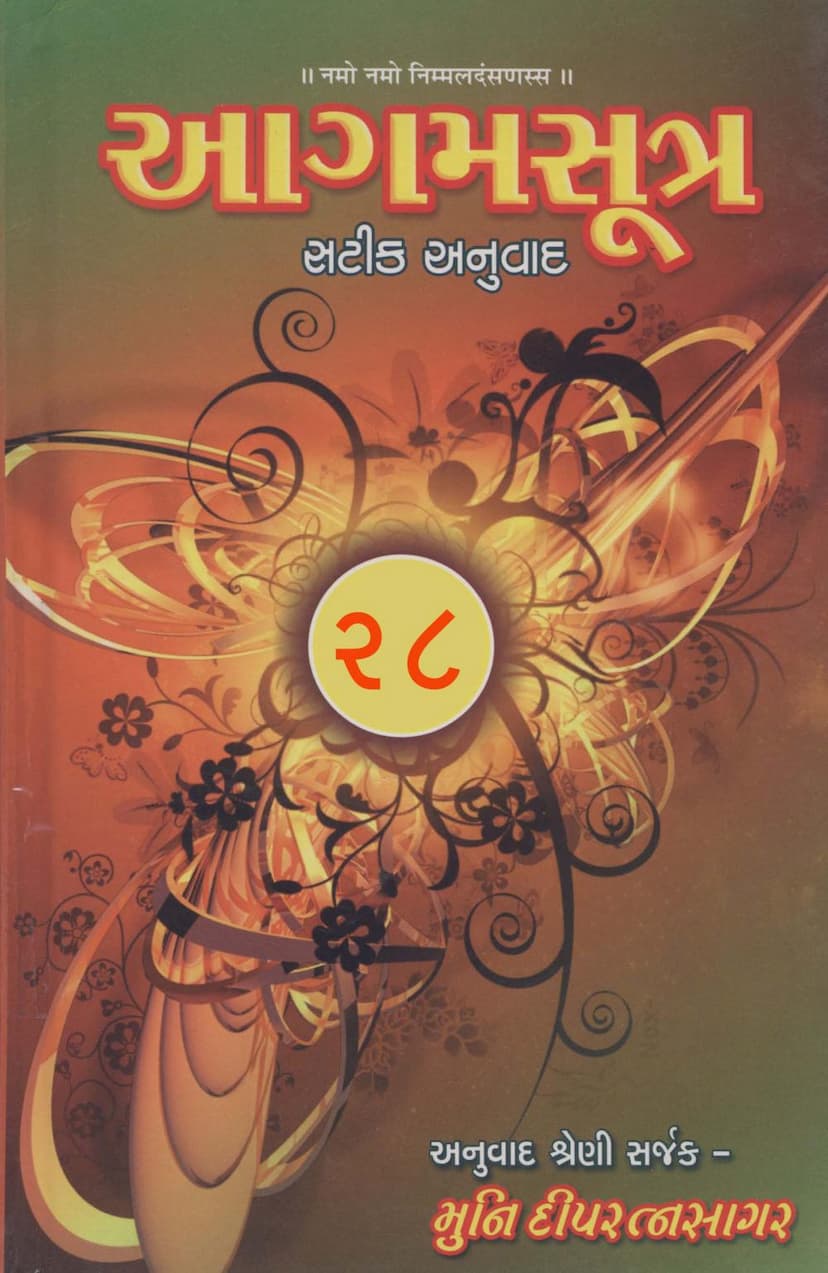Agam 26 Mahapratyakhyana Sutra Satik Gujarati Anuvad
Added to library: September 1, 2025

Summary
This document is a Gujarati translation and commentary of Jain Agam Sutras, specifically focusing on Agam 26, the Mahapratyakhyana Sutra (મહાપ્રત્યાખ્યાન સૂત્ર). The title of the work is "Agam 26 Mahapratyakhyana Sutra Satik Gujarati Anuvad," authored by Dipratnasagar and Deepratnasagar, and published by Deepratnasagar. The catalog link provided is jainqq.org/explore/009059/.
Here's a comprehensive summary of the provided pages:
Overall Purpose and Content:
The document is part of a larger series of translations and commentaries of Jain Agamas. This specific volume (Part 28 of the translation series) focuses on the Mahapratyakhyana Sutra, which is part of the "Pannasutta" (પન્નસૂત્ર) or "Payannao" (પયન્ના) category of Jain scriptures. The series aims to make the complex Jain Agamas accessible to a wider audience by providing detailed Gujarati translations and commentaries.
Key Highlights and Information:
- Series Creator: The translation and commentary series is created by Muni Deepratnasagarji.
- Scope of the Series: The introduction mentions that the complete translation series (Parts 1 to 42) covers a vast amount of Jain literature, including Upanga Sutras (like Nirayavalika Panchak), Panna Sutras (like Mahapratyakhyana), and other important texts.
- Sponsorship and Support: The project is supported by various Jain Sangh (communities) and individuals who have contributed financially. Several pages are dedicated to acknowledging these donors, indicating the collaborative nature of this extensive publication effort.
- The Mahapratyakhyana Sutra: Page 16 explicitly states that this volume contains the translation of Agam 26, the Mahapratyakhyana Prakirnak Sutra (મહાપ્રત્યાખ્યાન પ્રકીર્ણક સૂત્ર). It also notes that there is no known commentary (Vritti or Avachuri) for this particular sutra, hence only the original sutra's translation is provided.
- Content of the Mahapratyakhyana Sutra Translation (Pages 16-19):
- The translation consists of 142 verses (Gathas).
- The content reflects the core principles of renunciation, self-control, and spiritual discipline. Key themes include:
- Salutations and Reverence: Praising Tirthankaras, Siddhas, and Sadhus.
- Renunciation (Pratyakhyana/Vositava): Renouncing worldly attachments, emotions (like anger, pride, greed, attachment, aversion), and physical possessions. This includes the act of "Vosirava" or giving up, which is central to the sutra.
- Self-Reflection and Repentance: Acknowledging and confessing past wrongdoings (dosha) and seeking forgiveness. The importance of introspection and sincere confession before a Guru is highlighted.
- The Nature of the Soul: Emphasizing the soul's inherent singularity and its journey through karma and rebirth.
- Consequences of Actions: Discussing the cycle of birth and death and the suffering associated with worldly attachments and ignorance.
- The Path to Liberation: The sutra outlines the practices necessary for spiritual progress, including renunciation, self-control, meditation, and the adoption of the five great vows (Mahavratas).
- The Ideal Death (Pandit Maran): The text describes the importance of dying with equanimity and spiritual awareness, known as "Pandit Maran," as a means to attain liberation.
- The Role of a Guru: The importance of seeking guidance from a qualified Guru for understanding and practicing spiritual disciplines is repeatedly emphasized.
- Equanimity and Non-Attachment: The sutra advocates for equanimity towards all beings and detachment from worldly pleasures and pains.
- Categorization of Agams: Page 20 provides a table that categorizes the various Jain Agamas and the corresponding volume numbers within this translation series. It shows that the Mahapratyakhyana Sutra is covered in Volume 28.
- Other Publications by the Author/Publisher: Pages 8-15 list a wide range of other publications by Muni Deepratnasagarji, covering original Agamas, Gujarati translations, commentaries, dictionaries, grammatical works, discourses, rituals, and devotional literature. This demonstrates the prolific nature of their publishing efforts in promoting Jain scriptures.
In essence, this document is a valuable resource for those seeking to understand the Mahapratyakhyana Sutra, a significant Jain scripture dealing with the practices of renunciation, confession, and spiritual discipline, presented in Gujarati with scholarly commentary.